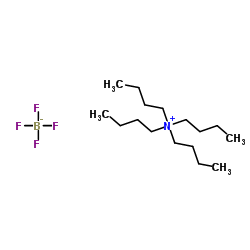Tetrabutylammonium tetrafluoroborate

Tetrabutylammonium tetrafluoroborate structure
|
Common Name | Tetrabutylammonium tetrafluoroborate | ||
|---|---|---|---|---|
| CAS Number | 429-42-5 | Molecular Weight | 329.268 | |
| Density | N/A | Boiling Point | N/A | |
| Molecular Formula | C16H36BF4N | Melting Point | 155-161 °C(lit.) | |
| MSDS | Chinese USA | Flash Point | >199.4 °F | |
| Symbol |


GHS05, GHS07 |
Signal Word | Danger | |
|
Diamond nanowires modified with poly[3-(pyrrolyl)carboxylic acid] for the immobilization of histidine-tagged peptides.
Analyst 139(17) , 4343-9, (2014) Coating boron-doped diamond nanowires (BDD NWs) with a conducting polymer, poly[3-(pyrrolyl)carboxylic acid], has been reported. Polymer coating was achieved through electropolymerization of 3-(pyrrolyl)carboxylic acid at the electrode interface by amperometr... |
|
|
Synthesis and spectral characterization of novel compounds derived from 1,10-phenanthroline, lead(II) and tetrabutylammonium tetrafluoroborate.
Spectrochim. Acta. A. Mol. Biomol. Spectrosc. 59(7) , 1655-62, (2003) On interacting 1,10-phenanthroline (phen) with tetrabutylammonium tetrafluoroborate (Bu4N*BF4) two novel compounds have been obtained. These are the 1:1 adduct (phen)*(Bu4N*BF4) and the complex Pb(phen)(Bu4N*BF4)3(NO3)2. The synthesized substances have been c... |
|
|
A fluoride-releasing composite for dental applications.
Dent. Mater. 17(2) , 127-33, (2001) The aim of this work was to attempt formulation of a dental composite, for investigational purposes, which will release fluoride at a rate comparable to glass ionomer materials, while retaining physical properties adequate for potential use in a number of den... |
|
|
Dentin pretreatment and caries inhibition by a fluoride-releasing resin.
Am. J. Dent. 6(4) , 204-6, (1993) The purpose of this study was to examine the effect that phosphoric acid etchant, used to remove the smear layer, may have on dentin demineralization inhibition. Fifteen molars had Class V preparations placed on the mesial and distal surfaces, the gingival se... |
|
|
Electrodeposition of metals from supercritical fluids.
Proc. Natl. Acad. Sci. U. S. A. 106(35) , 14768-72, (2009) Electrodeposition is a widely used materials-deposition technology with a number of unique features, in particular, the efficient use of starting materials, conformal, and directed coating. The properties of the solvent medium for electrodeposition are critic... |
|
|
Effect of electrolyte concentration on the viscosity and voltammetry of supercritical solutions.
Anal. Chem. 77(20) , 6702-8, (2005) The viscosity of a supercritical electrolyte solution is measured for the first time using a modified quartz crystal microbalance, and it is shown that ionic solvation leads to a significant structuring of the solvent and an appreciable increase in solution v... |